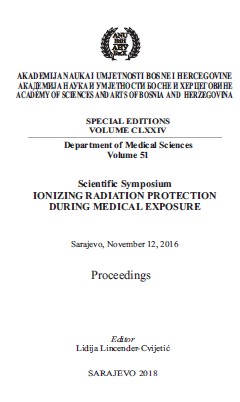RISK ASSESSMENT FROM IONIZING RADIATION IN MAMMOGRAPHY
RISK ASSESSMENT FROM IONIZING RADIATION IN MAMMOGRAPHY
Author(s): Suad Kunosic, Enver Zerem, Suada Kunosić, Esmeralda Kicić
Subject(s): Health and medicine and law
Published by: Akademija Nauka i Umjetnosti Bosne i Hercegovine
Keywords: risk; breast cancer; patient doses; routine mammography;
Summary/Abstract: Objective: This work aims to define patient doses and factors which influence them for all critical groups of patients in routine mammography. Methods: A level of risks and benefits of screening mammography is under constant scrutiny. The size which best describes the amount of risk for glandular tissue caused by application of radiation in mammography is called mean glandular dose. One hundred and five patients from 40 to 78 years of age were included in this study from the Department of Radiology of the University Clinical Center Tuzla. Clinical data were collected from 400 mammograms taken from 105 women from routine mammographic screening. The exposure conditions of each mammogram were recorded. The mean glandular dose was calculated based on measuring ESAK, half value layer, kVp, mAs, breast thickness and clinical spectrum. Results: Mean MGD for women between 40 and 49 was 1.22 ± 0.47 mGy, for the group between 50 and 64 mean MGD was 1.24 ± 0.45 mGy and 1.23 ± 0.40 mGy for the group between 65 and 78. According to the correlation analysis, there was significant statistical significance between the MGD and a CBT (r =0.709, p < 0.01). Conclusion: Values of MGD doses ranged within acceptable limits and were somewhat higher due to the extremely high value of compressed breast thickness.
Book: ZAŠTITA OD JONIZIRAJUĆEG ZRAČENJA KOD MEDICINSKE EKSPOZICIJE
- Page Range: 94-101
- Page Count: 8
- Publication Year: 2018
- Language: English
- Content File-PDF

